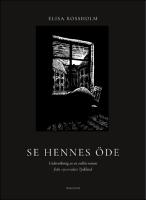Se hennes öde
Undersökning av en ordlös roman från 1920-talets Tyskland
| dc.contributor.author | Rossholm, Elisa | |
| dc.date.accessioned | 2023-01-23T10:19:46Z | |
| dc.date.available | 2023-01-23T10:19:46Z | |
| dc.date.issued | 2023 | |
| dc.identifier.uri | https://library.oapen.org/handle/20.500.12657/60863 | |
| dc.description.abstract | During the 1920s and 1930s the wordless novel – stories told in black-and-white wordless woodcuts – was established as a narrative genre. The genre was most popular in Germany, but was as well known in other parts of Europé and in the US. The wordless novel was characterized by the absence of words, the use of woodcut and other relief printing techniques, as well as themes of social critique and serious existential issues. The purpose of the book is to - through the wordless novels of the 1920s and 30s - explain the uniqueness of the wordless narrative and thus the autonomous narrative possibilities of the image. The method of the examination is a close reading of the German artist Otto Nückel's wordless novel Schicksal (Destiny 1926). A comparative material consists of the Czech artist Helena Bochořáková-Dittrichova's wordless novel Z Mého Dětství (From My Childhood, 1929). Wordlessness is studied through the image's characteristics as an intermediary of messages and narratives and through comparisons with other expressions - the silent film, cirkus, expressionist dance and visual art, as well as medieval woodcuts. Narratives – which are usually put together by verbal communication – are in this project a tool for seeing: the image sequences or the image groups that ""replace"" the words - not as a lack or implied meaning of words, but as a personal visual story. | en_US |
| dc.language | Swedish | en_US |
| dc.subject.classification | thema EDItEUR::A The Arts::AG The Arts: treatments and subjects::AGA History of art | en_US |
| dc.subject.classification | thema EDItEUR::W Lifestyle, Hobbies and Leisure::WF Handicrafts, decorative arts and crafts::WFT Book and paper crafts | en_US |
| dc.subject.classification | thema EDItEUR::J Society and Social Sciences::JB Society and culture: general::JBC Cultural and media studies::JBCC Cultural studies | en_US |
| dc.subject.classification | thema EDItEUR::D Biography, Literature and Literary studies | en_US |
| dc.subject.classification | thema EDItEUR::J Society and Social Sciences::JB Society and culture: general::JBC Cultural and media studies::JBCT Media studies | en_US |
| dc.subject.classification | thema EDItEUR::J Society and Social Sciences::JB Society and culture: general | en_US |
| dc.subject.other | Expressionism in black and white; Visual Story; German interwar graphic art; Otto Nückel; Wordless Books; Graphic novels | en_US |
| dc.title | Se hennes öde | en_US |
| dc.title.alternative | Undersökning av en ordlös roman från 1920-talets Tyskland | en_US |
| dc.type | book | |
| oapen.identifier.doi | 10.22188/kriterium.38 | en_US |
| oapen.relation.isPublishedBy | 7b034f4a-b816-4718-88ac-63b24c8e4b24 | en_US |
| oapen.relation.isbn | 9789170614262 | en_US |
| oapen.pages | 196 | en_US |
| oapen.remark.public | Funder name: Vitterhetsakademiens Bernadotteprogram Birgit och Gad Rausings stiftelse, Åke Wibergs stiftelse, Helge Ax:son Johnsons stiftelse/ Funder program: Vitterhetsakademiens Bernadotteprogram |

